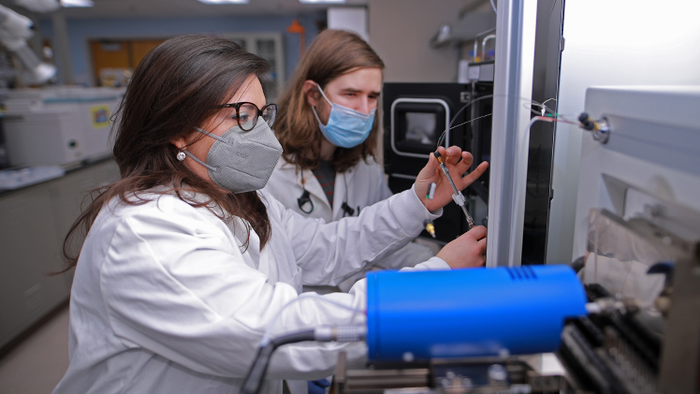Chemists at the University of Toledo discovered that new and unexplored wastewater contains many environmental contaminants, including organic chemicals and metallic elements, as companies that drill for oil and natural gas using hydraulic fracturing consider recycling and reusing wastewater that surfaces from wells during the fracking process.
 Left, Dr Emanuela Gionfriddo, assistant professor of analytical chemistry at The University of Toledo, and Ph.D. Candidate Ronald Emmons work in the Dr. Nina McClelland Laboratory for Water Chemistry and Environmental Analysis. Their new research provides information that can help regulatory agencies fine-tune proposed guidelines related to the safe treatment and disposal of fracking wastewater. Image Credit: Daniel Miller, The University of Toledo.
Left, Dr Emanuela Gionfriddo, assistant professor of analytical chemistry at The University of Toledo, and Ph.D. Candidate Ronald Emmons work in the Dr. Nina McClelland Laboratory for Water Chemistry and Environmental Analysis. Their new research provides information that can help regulatory agencies fine-tune proposed guidelines related to the safe treatment and disposal of fracking wastewater. Image Credit: Daniel Miller, The University of Toledo.
At the University of Toledo (UToledo)’s Dr. Nina McClelland Laboratory for Water Chemistry and Environmental Analysis, research scientists in collaboration with the University of Texas Arlington have been successful in achieving an extensive characterization of the chemical composition of produced water samples extracted in Texas.
It indicated the existence of poisonous and carcinogenic contaminants in untreated samples, thereby posing a threat to human health and wildlife.
Disclosing the complicated composition of produced water by specialized extraction methodologies, the outcomes offer crucial data that can assist regulatory agencies to fine-tune proposed guidelines connected to the safe treatment and disposal of fracking wastewater to safeguard drinking water sources. The study was published in the journal Environmental Science and Technology.
The discovery of these chemicals in produced water suggests that greater monitoring and remediation efforts are needed since many of them are listed to be dangerous for human health by the World Health Organization.
Dr. Emanuela Gionfriddo, Assistant Professor, Analytical Chemistry, Department of Chemistry and Biochemistry, School of Green Chemistry and Engineering, University of Toledo
Gionfriddo added, “Our comprehensive characterization sheds insight into the processes taking place during hydraulic fracturing and the nature of the geologic formation of each well site.”
Frequently, drilling operations have been executed by injecting treated water into the subsurface consisting of various publicly hidden additives to aid in the drilling process. The injected water gets mixed with the groundwater and further resurfaces as a waste byproduct consisting of contaminants both from the drilling site and the additives utilized.
The chemists utilized a method that was developed by Gionfriddo’s research group in 2020 known as thin-film, solid-phase microextraction to withdraw organic solubles obtained from eight produced water samples from the Eagle Ford formation and Permian Basin in Texas.
The analysis performed discovered around a total of 266 various dissolved organic compounds, such as a pesticide known as atrazine; 1,4-dioxane, an organic compound that irritates the eyes and respiratory tract; pyridine, a chemical that might harm the liver; and polycyclic aromatic hydrocarbons (PAHs) linked to skin, lung, stomach, bladder and liver cancers.
With the help of a new polymer developed in 2021 at UToledo, the team also verified the existence of 29 elements, such as rare earth elements, selenium, and dangerous metals like uranium, lead, chromium and cadmium.
Furthermore, the scientists also indicate that the technology utilized for their extensive analysis of produced water is crucial for correct reuse or disposal by oil and gas producers.
We found a way to use more accessible instrumentation in the analysis of such complex samples compared to more expensive workflows involving high-resolution mass spectrometry.
Dr. Jon Kirchhoff, Distinguished Professor and Chair, Department of Chemistry and Biochemistry, University of Toledo
Journal Reference:
Emmons, R. V., et al (2022) Unraveling the Complex Composition of Produced Water by Specialized Extraction Methodologies. Environmental Science & Technology. doi.org/10.1021/acs.est.1c05826.